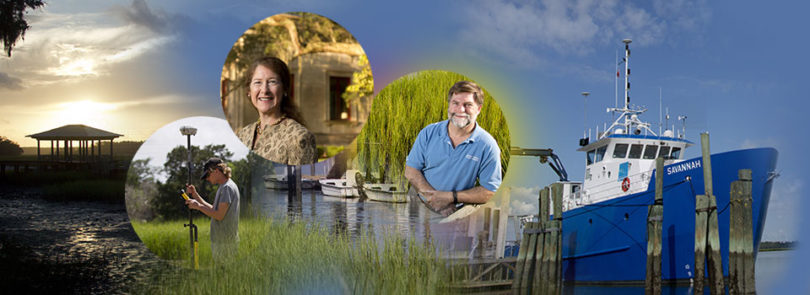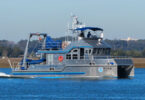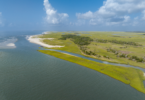Teams of UGA scientists are seeking to answer fundamental questions about coastal areas, which provide habitat for fish and birds, protect against storm surges, filter impurities from the water, and are home to an increasing human population. Given the effects of climate change, development and other environmental concerns, the answers couldn’t be more timely. “Climate change and human activities are changing coastal ecosystems,” says Merryl Alber, UGA professor of marine science based in Athens, “and we’re in a position to discern those trends.”
That position recently became a lot stronger. In July, when the Skidaway Institute of Oceanography became part of UGA, the university’s marine science faculty was significantly expanded. In addition, a recent gift to UGA from the Wormsloe Foundation -15 acres adjacent to the Wormsloe State Historic Site near Savannah-has expanded interdisciplinary research in one of the Georgia’s most notable coastal landscapes.
“What impresses me most about our coastal research,” says Zell Miller Distinguished Professor in Higher Education Libby V. Morris, who previously served as interim senior vice president for academic affairs and provost, “is how it brings researchers from disparate fields together to collaborate on projects that are of vital importance to the future of our state.”
A productive Marine Institute
On 1,500 acres of Sapelo Island, a pristine barrier island once owned by tobacco magnate R.J. Reynolds, sits the UGA Marine Institute. Reynolds’ interest in promoting research led to the creation of a foundation that, in 1953, made funds available for establishing this institute. Alber, who was recently named director of the institute, also directs one of its projects, known as the Georgia Coastal Ecosystems Long-Term Ecological Research Program. Supported by the National Science Foundation, the program began in 2000 and was recently awarded $5.8 million to continue through at least 2018. Investigators from several departments at UGA and six other institutions nationwide are involved in the program, which to date has resulted in more than 200 research papers and nearly 75 book chapters and dissertations.
For example, LTER researchers are studying the ecologically sensitive marshes on the mainland, where rising sea levels will push saltwater into areas that were previously freshwater. A team led by Chris Craft of Indiana University has created 30 plots, each approximately 8 by 8 feet, in which scientists manipulate the salt concentration of the water to see how the plants and animals respond.
A visit to one of these sites underscores just how labor-intensive this work can be. Working in the marshes can be a hot and muddy experience, where researchers are harassed by insects and surrounded by the aptly named giant cutgrass, which has painfully sharp serrated blades. Preliminary data suggest that the ground is being eaten out from under these ecosystems. Decomposition in freshwater marshes is typically a slow process, Craft explains, but the saltwater enables bacteria to thrive and rapidly consume the plant matter that provides the foundation for a marsh. “There’s a concern that these marshes could just shift to open water within 10 years,” Craft says.
Skidaway’s diverse projects
Like the UGA Marine Institute, the Skidaway Institute of Oceanography traces its history to the generosity of a donor and an understanding that humans and their environment are inextricably linked. Robert C. Roebling, the great-grandson of the man who designed the Brooklyn Bridge, donated to the state of Georgia some 700 acres on the tip of Skidaway Island near Savannah for the establishment of a marine research facility. In 2013, the institute merged with UGA as part of the efforts of Hank Huckaby, chancellor of the University System of Georgia, to streamline system operations.
Skidaway’s 11 full-time faculty members conduct research around the world and are particularly well known for helping to explain how the continental shelves that ring landmasses influence processes in the deep ocean and on land. “All of these processes are so interconnected that everyone on the coast and in the region should be interested in the kinds of things that we’re studying,” says Skidaway Institute Executive Director James Sanders.
For example, in a study recently published in the journal Science, Skidaway researcher Aron Stubbins worked with an international team of scientists to quantify the proportion of carbon released by the burning of biomass that reaches the oceans-a critical piece of information for climate-change models. Richard Lee is assessing how exposure to contaminants affects shrimp development, and Catherine Edwards is using the institute’s 92-foot research vessel, the R/V Savannah, and autonomous torpedo-shaped gliders to understand what triggers the phytoplankton blooms that support thriving fisheries in the Southeast.
Skidaway faculty have a long history of joint efforts with scientists from UGA and other University System of Georgia institutions, and those collaborations continue. Skidaway professor Clark Alexander has worked with Alber since the 1990s, and he is currently helping to lead an LTER project that is assessing the effect of bulkheads, which are wood, concrete or steel walls placed along the transition zone between the salt marsh and the uplands, on ecosystem health. This past summer, a team of graduate and undergraduate students surveyed 60 sites along the coast to measure bulkheads’ alterations of the flow of sediment, water, and energy between the marsh and the upland.
Alexander notes that this so-called “armoring,” which includes not only bulkheads but also other structures, is typically installed to prevent upland erosion. Unfortunately, it also creates a barrier that prevents the marshes from migrating upland in response to sea-level rise. Scientists anticipate a rise of up to three feet on Georgia’s coast by 2100, which means that salt marshes, like freshwater marshes inland, are at risk. “The long-term prospect in areas of armoring is that you’re going to lose your salt marsh,” says Alexander.
Studying Wormsloe’s history and ecology
Just a mile or so from the Skidaway Institute and down the road from gas stations, shopping centers and other accouterments of modern life is a site called Wormsloe that preserves layer upon layer of cultural and natural history. Oyster shell deposits and other artifacts found at the site suggest that Native Americans occupied it some 6,000 years ago. In 1736, King George II transferred the site to Noble Jones, one of Georgia’s original colonists, and ruins where Jones’ fortified house once stood are the oldest standing structure in the state. Today, Craig Barrow III is the ninth generation of Jones’ descendants to live on the site, and he and his wife, Diana, have encouraged UGA researchers to delve deeper into its history and ecology.
Barrow and his father donated 822 acres of Wormsloe to the state in 1973 to create the Wormsloe State Historic Site, now a popular tourist destination. In 2007, the Wormsloe Foundation began funding interdisciplinary graduate studies for UGA students through the Wormsloe Fellows program. The foundation’s recent gift of 15 acres to create the UGA Center for Research and Education at Wormsloe will expand research opportunities even further.
The marshes at Wormsloe have served as one of the pristine control sites for the LTER bulkhead research, and faculty from UGA’s School of Ecology and School of Forestry and Natural Resources have established study sites there to compare how the presence of native versus non-native plants affect the density of butterflies and other pollinators. Researchers from the university’s Center for Geospatial Research, College of Engineering and other units are exploring whether the site was used for rice cultivation. Just this summer, they used ground-penetrating radar and other technologies to pinpoint the foundation of a rice mill dating back to the late 1700s.
Sarah Ross, president of the Wormsloe Foundation and director of the Wormsloe Institute for Environmental History, notes that discerning how the land was used in the past is essential for prioritizing future conservation and preservation efforts. Truly understanding a site as complex as Wormsloe, she says, requires expertise from throughout the physical and social sciences, as well as the humanities. “We are truly interdisciplinary here because the site requires it,” Ross said, “and the expertise that’s on [the UGA] campus is unparalleled for what we need.”
UGA scholars and students visiting Wormsloe are currently housed in a cabin constructed in the 1840s that sleeps two, but efforts are underway to construct a new cabin to house an additional six researchers. The university aims to build three additional cabins as well as a research lab and educational center on the site over the next decade. Associate professor Cari Goetcheus of the College of Environment and Design is cataloging Wormsloe’s cultural features as part of a bid to make it one of the few World Heritage Sites in the United States, while David Spooner and Umit Yilmaz are working on a master plan and architectural designs for the new facilities that would minimize environmental impact and maintain the historic character of the site.
Building on strengths
UGA’s merger with the Skidaway Institute presents new educational opportunities as well, such as an expansion of graduate educational opportunities and a proposed “Semester on the Coast” for undergraduates. The state-of-the-art Marine and Coastal Science Research and Instructional Center at Skidaway was completed in 2009, and the institute also includes apartments and cottages for visiting scientists.
On Sapelo, construction is currently underway to provide a new meeting and dining facility. Friends of the UGA Marine Institute, a group of volunteers, is working on several projects, including restoration of the greenhouse. In addition, recent improvements in housing for students and scientists, new lab space and renovations to a historic auditorium (once R.J. Reynolds’ personal movie theater) have added a new vitality to an institute that has long been an internationally recognized center for salt-marsh research. “Our marine programs have always been very strong,” says Brian Binder, head of the Department of Marine Sciences, “but these days there’s a lot of excitement about how we’re going to build on that history.”





